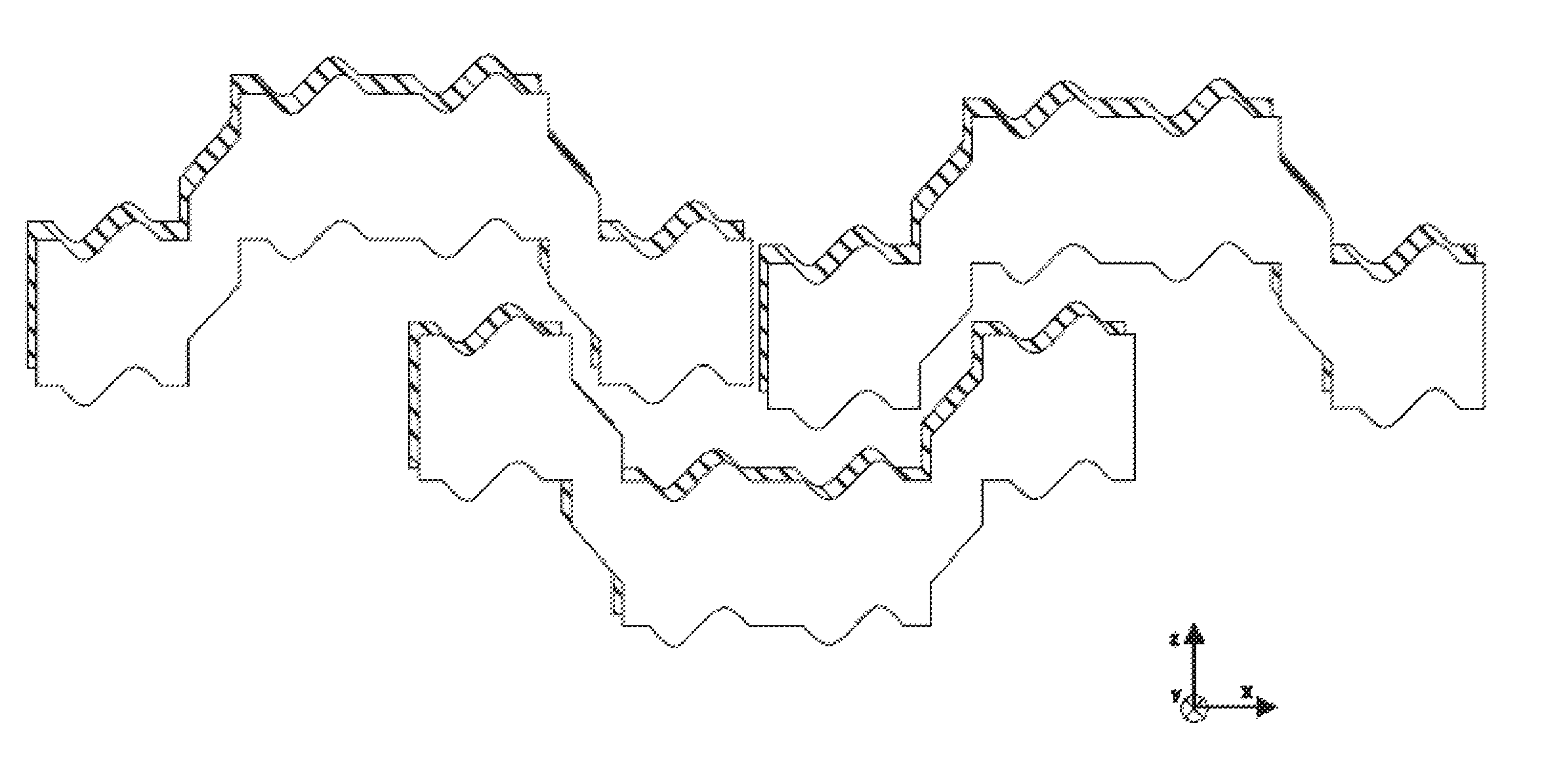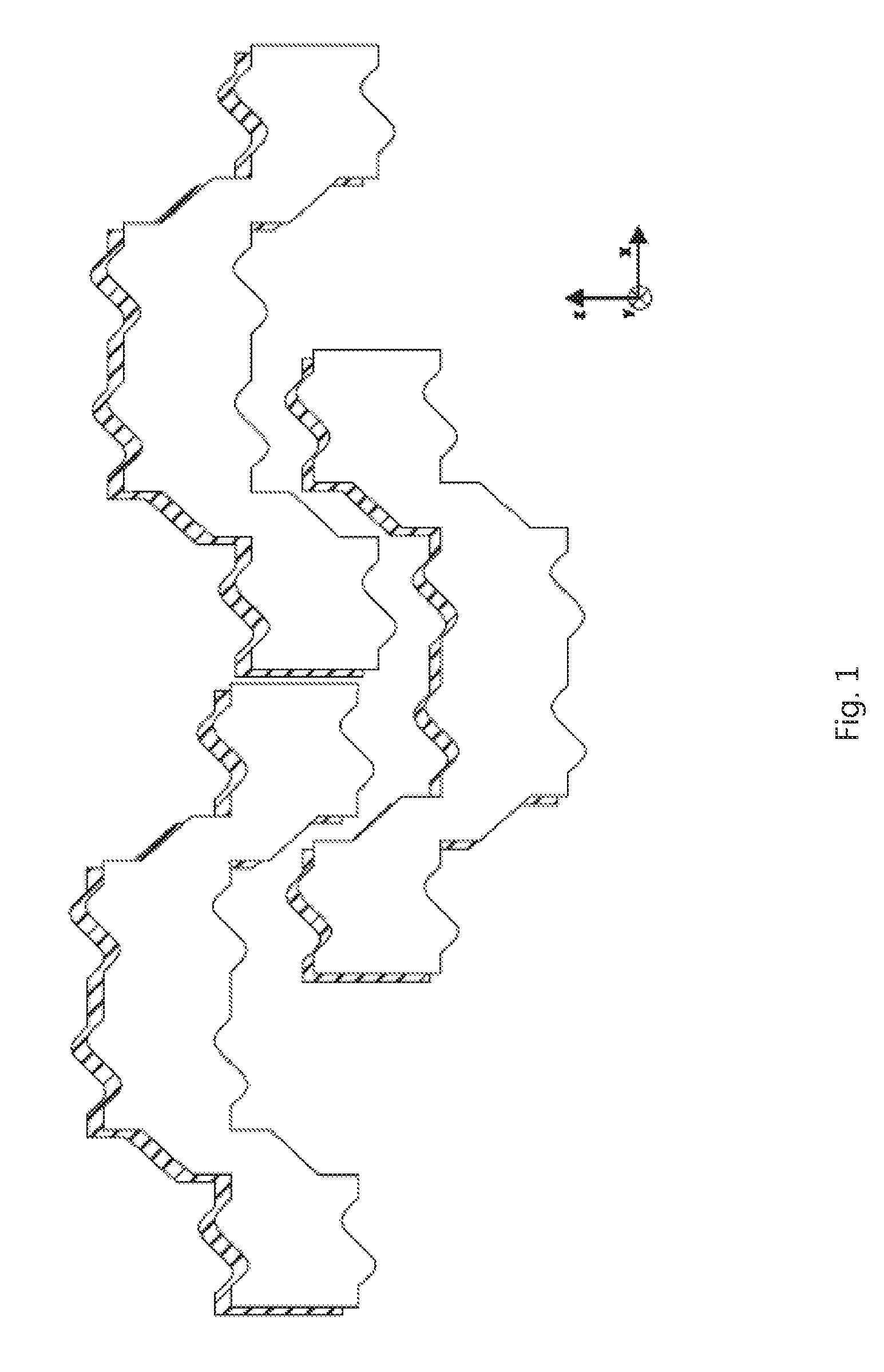Stackable surface module for a wall surface
a technology of a wall surface and a stacking module, which is applied in the direction of load-supporting elements, structural elements, building components, etc., can solve the problems of not being able to remove elements on both sides (left/right and front/back) from the erected wall without removing, and the module is therefore unsuitabl
- Summary
- Abstract
- Description
- Claims
- Application Information
AI Technical Summary
Benefits of technology
Problems solved by technology
Method used
Image
Examples
example 1 (
Angular U-shape)
[0433]The module is made of plastic and has a constant thickness of 1.5 cm in the y-direction. The maximum extent in the x-direction is 30 cm. The maximum extent in the z-direction is 12 cm. The module has an angular U-shape. Starting with a rectangular basic form having the above dimensions, a rectangular recess is cut out from the lower part in the middle of the x-direction with a length of 15 cm (in the x-direction), a width of 6 cm (in the z-direction) and a thickness of 1.5 cm (in the y-direction). In the following, the module is described when being viewed from the front. The front profile is constant in the y-direction. The edge lengths of the surfaces of the module in the counterclockwise direction are listed in the following, starting with the lower left corner of the module. The angle information is in brackets, starting from the end point of the previous edge corresponding to the normal degree distribution of a unit circle in 360° in the counterclockwise d...
example 2 (
Simple H-shape)
[0435]The module according to the invention is made of plastic and has a constant thickness of 1.5 cm in the y-direction. The maximum extent in the x-direction is 30 cm. The maximum extent in the z-direction is 24 cm. The module is H-shaped. Starting with a rectangular basic form having the above dimensions, a rectangular recess is cut out from the lower and upper parts in the middle of the x-direction each with a length of 15 cm (in the x-direction), a width of 8 cm (in the z-direction) and a thickness of 1.5 cm (in the y-direction). In the following, the module is described when being viewed from the front. The front profile is constant in the y-direction. The edge lengths of the surfaces of the module in the counterclockwise direction are listed in the following, starting with the lower left corner of the module. The angle information is in brackets, starting from the end point of the previous edge corresponding to the normal degree distribution of a unit circle in...
example 3 (
H-shape with Sinusoidal Horizontal Edges)
[0439]A module with sinusoidal horizontal surfaces can be modeled on the basis of the H-shaped module in Example 2. The module is also made of plastic and has in principle the same basic surfaces as in Example 2.
[0440]In a variant made of concrete, all lengths (as well as heights and thicknesses must be multiplied by a factor of 3 to 15. In a variant made of wood, the lengths must be multiplied by a factor of 2 to 7.
[0441]Here, each of the six horizontal surfaces (with an angle of 0° or 180°, i.e. UALE, SI, UARE, OARE, II and OALE) has at least one sine wave. The lower and upper outer edges of the extensions (UALE, UARE, OARE and OALE) are so formed that the sine wave starts to rise at the straight distance of 0.75 cm from the left corner of the edge. The gain in area in the case of an upper edge or the loss of area in the case of the lower edge in comparison with Example 2 increases sinusoidally in the x-direction up to a maximum height of 1...
PUM
 Login to View More
Login to View More Abstract
Description
Claims
Application Information
 Login to View More
Login to View More - R&D
- Intellectual Property
- Life Sciences
- Materials
- Tech Scout
- Unparalleled Data Quality
- Higher Quality Content
- 60% Fewer Hallucinations
Browse by: Latest US Patents, China's latest patents, Technical Efficacy Thesaurus, Application Domain, Technology Topic, Popular Technical Reports.
© 2025 PatSnap. All rights reserved.Legal|Privacy policy|Modern Slavery Act Transparency Statement|Sitemap|About US| Contact US: help@patsnap.com



